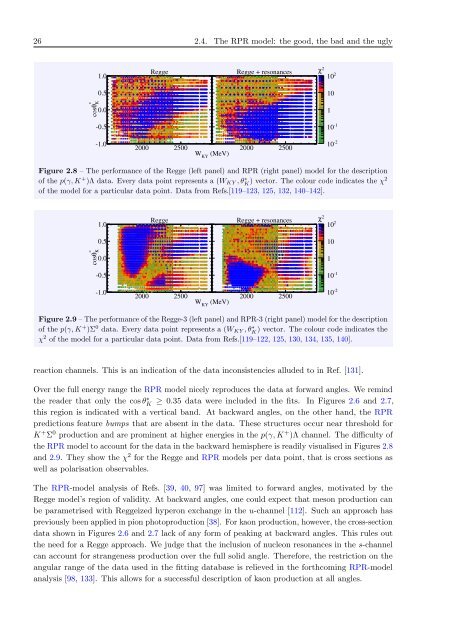Download Thesis in Pdf Format - Theoretical Nuclear Physics and ...
Download Thesis in Pdf Format - Theoretical Nuclear Physics and ...
Download Thesis in Pdf Format - Theoretical Nuclear Physics and ...
Create successful ePaper yourself
Turn your PDF publications into a flip-book with our unique Google optimized e-Paper software.
26 2.4. The RPR model: the good, the bad <strong>and</strong> the ugly1.0Regge1.0Regge + resonancesχ 210 20.50.510cosθ K*0.00.010.50.510 11.02000 25001.0(MeV)W KY2000 250010 2Figure 2.8 – The performance of the Regge (left panel) <strong>and</strong> RPR (right panel) model for the descriptionof the p(γ, K + )Λ data. Every data po<strong>in</strong>t represents a (W KY , θK ∗ ) vector. The colour code <strong>in</strong>dicates the χ2of the model for a particular data po<strong>in</strong>t. Data from Refs.[119–123, 125, 132, 140–142].1.0Regge1.0Regge + resonancesχ 210 20.50.510cosθ K*0.00.010.50.510 11.02000 25001.0(MeV)W KY2000 250010 2Figure 2.9 – The performance of the Regge-3 (left panel) <strong>and</strong> RPR-3 (right panel) model for the descriptionof the p(γ, K + )Σ 0 data. Every data po<strong>in</strong>t represents a (W KY , θK ∗ ) vector. The colour code <strong>in</strong>dicates theχ 2 of the model for a particular data po<strong>in</strong>t. Data from Refs.[119–122, 125, 130, 134, 135, 140].reaction channels. This is an <strong>in</strong>dication of the data <strong>in</strong>consistencies alluded to <strong>in</strong> Ref. [131].Over the full energy range the RPR model nicely reproduces the data at forward angles. We rem<strong>in</strong>dthe reader that only the cos θK ∗ ≥ 0.35 data were <strong>in</strong>cluded <strong>in</strong> the fits. In Figures 2.6 <strong>and</strong> 2.7,this region is <strong>in</strong>dicated with a vertical b<strong>and</strong>. At backward angles, on the other h<strong>and</strong>, the RPRpredictions feature bumps that are absent <strong>in</strong> the data. These structures occur near threshold forK + Σ 0 production <strong>and</strong> are prom<strong>in</strong>ent at higher energies <strong>in</strong> the p(γ, K + )Λ channel. The difficulty ofthe RPR model to account for the data <strong>in</strong> the backward hemisphere is readily visualised <strong>in</strong> Figures 2.8<strong>and</strong> 2.9. They show the χ 2 for the Regge <strong>and</strong> RPR models per data po<strong>in</strong>t, that is cross sections aswell as polarisation observables.The RPR-model analysis of Refs. [39, 40, 97] was limited to forward angles, motivated by theRegge model’s region of validity. At backward angles, one could expect that meson production canbe parametrised with Reggeized hyperon exchange <strong>in</strong> the u-channel [112]. Such an approach haspreviously been applied <strong>in</strong> pion photoproduction [38]. For kaon production, however, the cross-sectiondata shown <strong>in</strong> Figures 2.6 <strong>and</strong> 2.7 lack of any form of peak<strong>in</strong>g at backward angles. This rules outthe need for a Regge approach. We judge that the <strong>in</strong>clusion of nucleon resonances <strong>in</strong> the s-channelcan account for strangeness production over the full solid angle. Therefore, the restriction on theangular range of the data used <strong>in</strong> the fitt<strong>in</strong>g database is relieved <strong>in</strong> the forthcom<strong>in</strong>g RPR-modelanalysis [98, 133]. This allows for a successful description of kaon production at all angles.















